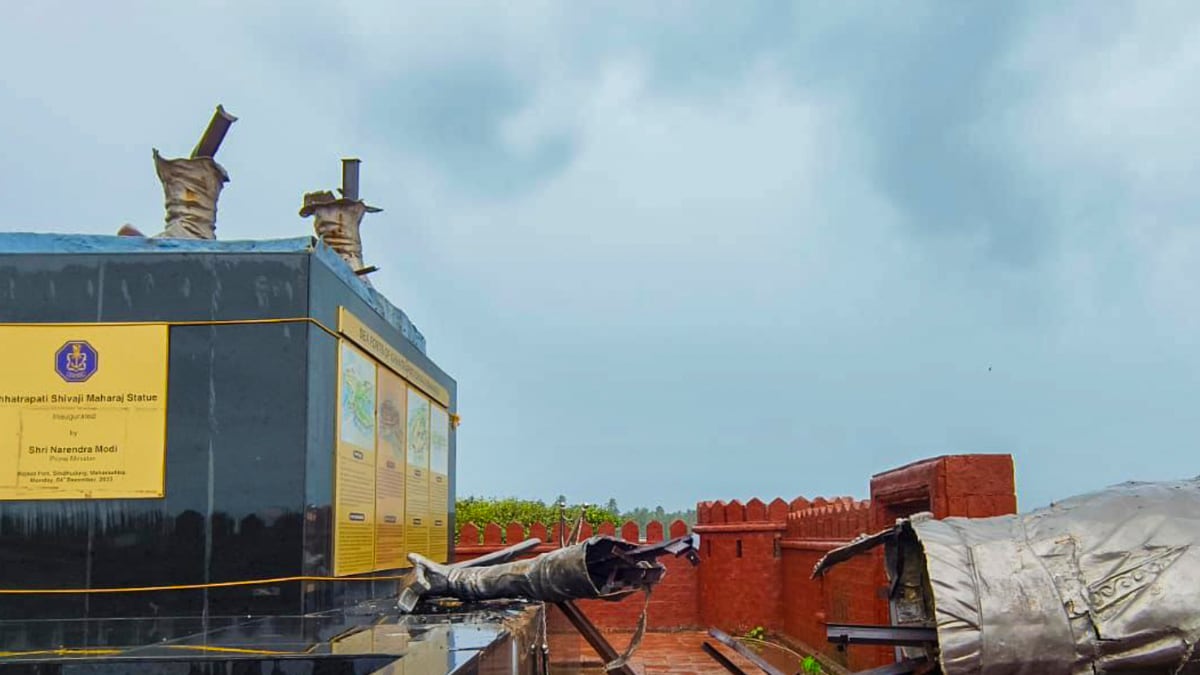The collapse of the Chhatrapati Shivaji Maharaj statue at Fort Rajkot in Maharashtra has sparked controversy and raised questions about the quality of construction and oversight. The incident, which occurred on August 26, 2023, brought the role of structural consultant Chetan Patil into focus, leading to his arrest by Maharashtra Police. While Patil initially denied involvement in the statue’s design and construction, investigations revealed crucial details regarding his role and the circumstances surrounding the collapse.
The Collapse and Initial Investigations
The 35-foot statue, a tribute to the 17th-century Maratha empire founder, was unveiled by Prime Minister Narendra Modi in December 2022. The structure, installed at Rajkot Fort in Sindhudurg district’s Malvan tehsil, was a symbol of pride and patriotism for many in Maharashtra. However, less than a year after its grand unveiling, the statue came crashing down. This unexpected event prompted a wave of shock and disbelief, quickly followed by calls for a thorough investigation to determine the cause of the collapse. The Maharashtra government, led by Chief Minister Eknath Shinde, swiftly took action, ordering an investigation into the incident by the Indian Navy, which was responsible for the statue’s design and construction.
The Accusations and Denials
In the aftermath of the collapse, fingers pointed towards Chetan Patil, the structural consultant named in the FIR regarding the statue’s construction. While Patil initially claimed that he was not involved in the statue’s design and construction, focusing solely on the platform’s design, further investigations unveiled crucial details that challenged his claim. Patil’s statement, given to the Marathi news channel ABP Majha, suggested a possible disconnect in responsibility and a lack of comprehensive oversight for the project.
The Role of the Indian Navy
The Indian Navy, responsible for the statue’s design and construction, came under scrutiny following the incident. The Maharashtra Public Works Department (PWD), in a letter sent just six days before the collapse, raised concerns about the gathering of rust on the statue, urging the Navy to implement permanent measures. This letter highlights potential red flags regarding the statue’s integrity and raises questions about the thoroughness of the Navy’s oversight during the project.
Chetan Patil’s Arrest
In a significant development, the Kolhapur Police crime branch tracked down Chetan Patil and arrested him in the early hours of Friday. His arrest follows investigations that shed light on his involvement in the project, contradicting his initial claims. While further investigations are expected, Patil’s arrest serves as a crucial step towards unraveling the truth behind the collapse. The charges against Patil, and any potential consequences, remain to be determined.
Seeking Transparency and Accountability
The incident has brought to light the importance of transparency and accountability in large-scale construction projects. The focus now shifts towards a detailed and thorough investigation, aiming to determine the precise cause of the statue’s collapse and to ensure such incidents are prevented in the future. Lessons must be learned from this experience to ensure the safety and integrity of future public projects.
Lessons Learned from the Incident
The collapse of the Chhatrapati Shivaji Maharaj statue raises concerns about the overall quality control and oversight involved in such projects. The incident underscores the need for:
- Thorough quality control measures: A stringent system of quality control is critical in preventing such incidents. Regular inspections and evaluations are crucial for identifying potential risks and addressing them proactively.
- Effective communication and collaboration: Open communication between different agencies and contractors involved in projects is vital to avoid any potential disconnect in responsibility or miscommunication.
- Transparent and accountable investigations: Transparency in investigations is key to ensuring public confidence and holding all responsible parties accountable for their actions.
Takeaways
The collapse of the Chhatrapati Shivaji Maharaj statue at Fort Rajkot highlights the need for stricter regulations and thorough oversight in large-scale construction projects. The incident also reinforces the importance of transparency and accountability in all stages of project execution, from design to implementation. The investigations must uncover all the facts and ensure those responsible for the collapse are held accountable. Only then can we learn from this tragedy and work towards ensuring the safety and integrity of future public projects.









